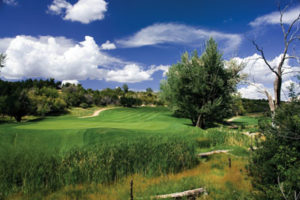While restoring the land from a degraded uranium mill to its natural condition, Arthur Jack Snyder, ASGCA and Forrest Richardson, ASGCA worked with the town of Monticello, Utah, the U.S. Department of Energy (DOE), and the Environmental Protection Agency (EPA) to develop a financially successful golf course that provides numerous environmental benefits.
From the 1940s through the 1960s, Monticello was home to a large uranium mill consuming nearly 100 acres. The mill was subsidized by the U.S. government for its part in defense efforts, and in the 1980s, the DOE had undertaken the removal of the mill site. Since the mill land was under federal oversight, the best use was to return it, once totally clean, to the public. Under directives from the EPA, the DOE had to clean up the mill site and restore the land to a natural condition.
The DOE wanted to find the best possible use for the land, one that would assist the city in both environmental and economic terms. The mill site was located right across the highway from an old nine-hole golf course, and with the DOE’s commitment to return the land to a suitable condition, the town thought there might be potential for an expansion of the old course using the land occupied by the mill. The town also thought such a plan would provide a needed economic boost, as there had not been much of an economic base in the town since the mill’s closure.
The golf course architects and team of consultants assisted the town in determining the physical viability and environmental issues involved in the expansion and development of the golf course. Among the environmental issues considered were stabilization of hillside topsoil, wetlands establishment and configuration, wildlife corridors and habitat enhancement, and stream alignment. The architects and consultants concluded that all of these environmental considerations could be met through the development of a golf course at the mill site, and doing so would not have any negative effects to restoration; rather, the operation and maintenance required by the golf course would actually be positive to the long term viability and stabilization of the site.

Hole 5, The Hideout Golf Club, Monticello, Utah
A variety of options were explored in the preliminary routing of the golf course, including using the existing nine holes and adding nine more on the mill site, or scrapping the existing course and building the entire facility on the mill site. The terrain of the old uranium mill proved to be a difficult site, however, due to its steep slopes that were void of any vegetation. As a result, the golf course architects suggested to build the course apart from the old mill site, on detached land; there would be two simultaneous projects, one to restore the old mill land and another to build a new golf course.
The city eventually acquired the land to fulfill this option, and, by doing so, created a large and expansive area of open space for the community. The expansive and fluid greenbelt connects the town with continuous open space of a national forest and provides wildlife with an unobstructed and protected corridor to move across an existing highway from low to high ground. Keeping golf uses together also significantly reduced water use, as separation by a highway would have meant two water reservoirs and significant pumping.
Construction on The Hideout Golf Club involved moving just 80,000 cubic yards of earth, with holes carefully routed in natural glens and across ridges. The work included a fully automatic irrigation system delivering water to 85 acres of turf. The golf course architects also worked with the golf course builder to find effective solutions for environmentally sensitive areas of the course that needed to be preserved during construction, such as naturally running springs, wetlands habitats, and forested areas. The team also restored an existing stream to its historic alignment and incorporated wetland pockets, a trail system, and stabilized grassland slopes.
As a result of the creative funding and work strategy implemented on the project, the town was able to save extra funds that will eventually be used to develop an interpretative center, explaining the uranium legacy of the region. In working closely with representatives of the town and regulatory agencies, the golf course architects and design developed a profitable and environmentally-friendly golf course.
To read more Environmental Case Studies, please visit here.
